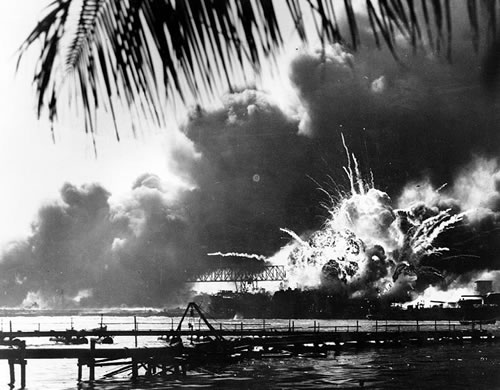
On December 7, 1941, a Sunday morning, the Japanese navy executed a covert attack on the American naval base Pearl Harbor in Hawaii. The attack would influence U.S. involvement in World War II as well as President Truman's decision to use nuclear weapons against Japan, more specifically the atomic bombs on Hiroshima and Nagasaki in 1945.
One of the earliest press releases of the attack read "Tokyo Bombers Strike Hard At Our Main Bases on Oahu", and was published in the New York Times. The article is fairly objective, providing a detailed description of the turn of events that morning and through the afternoon. Also provided was a map of the Naval Base with labeled areas of casualties and points of attack. In addition to the briefing were Japanese news reports reading, "[The Japanese news agency, Domei reported that the battleship Oklahoma had been sunk at Pearl Harbor, according to a United press dispatch from Shanghai.]" [1]
Similar to 9/11 speculations, the article would also write about intelligence that had already predicted the attack, "...United States forces here had known for a week that the attack was coming and they were not caught unprepared."
More information would then go into explaining that it had all happened so suddenly and that after "the shock of the first bomb impacts had been absorbed, Governor Joseph B. Poindexter declared a stated of emergency." [1]
The American consciousness must have indeed been in a state of shock. Another article would provoke a greater sentiment of anxiety than that of the first - "Tokyo Acts First". The article begins with a type of public service announcement of declared war by Japan against the United States and Britain. "Japanese Imperial headquarters announced at 6 A.M. [4 P.M. SUnday, Eastern standard time] that a state of war existed among these nations in the Western Pacific, as of dawn." [2] The article is brief and and evokes a senses of both hostility and urgency, tonally different than the first.
Through sensitive times of tragedy and war, objective journalism becomes essential in keeping stability in an environment of fear. A year later, the New York times would write articles describing a strong sense of nationalism and heroism among the survivors and soldiers of Pearl Harbor. They would affirm a sense of security and pride. They end an article with reassurance that "the Hawaiian Department is on the offensive against the enemy. With the seventh Air Force, Hawaii's own, sending its heavy bombardment groups against Japanese positions and shipping as far away as the Solomon Islands."[3]
///ICHAEL DE VERA
1/// Tokyo Bombers Strike Hard At Our Main Bases on Oahu by The United Press. New York Times (1867-Current file); Dec 8, 1941; ProQuest Historical Newspapers The New YOrk Times (1851-2005
2/// TOKYO ACTS FIRST by the Associated Press. New York Times (1857-Current file); Dec 8, 1942; ProQuest HIstorical Newspapers The New York TImes (1851-2005) p.1
3/// EMMONS PREDICTS ACTION New York Times (1857-Current file); Dec 7, 1942; ProQuest Historical Newspapers The New York Times (1851-2005) p.6
No comments:
Post a Comment